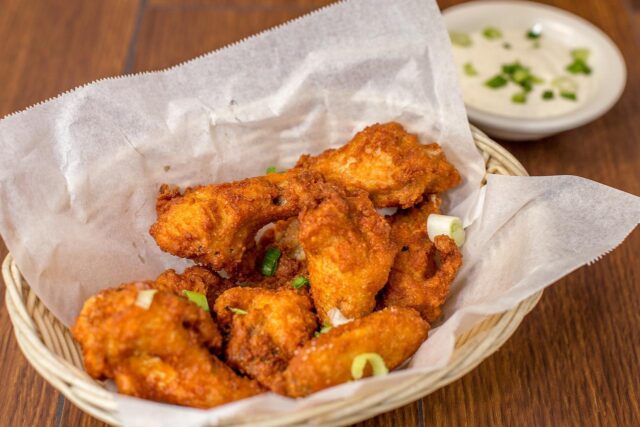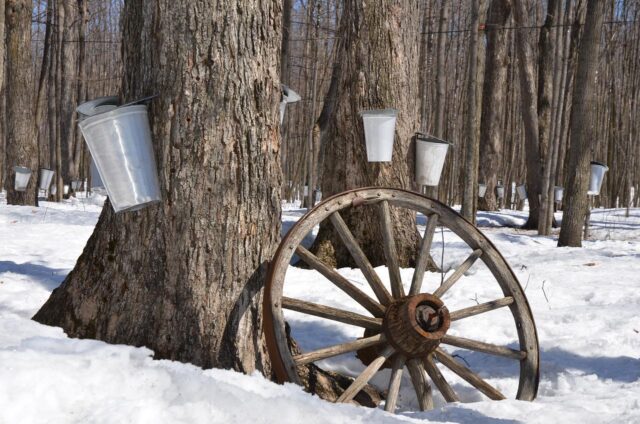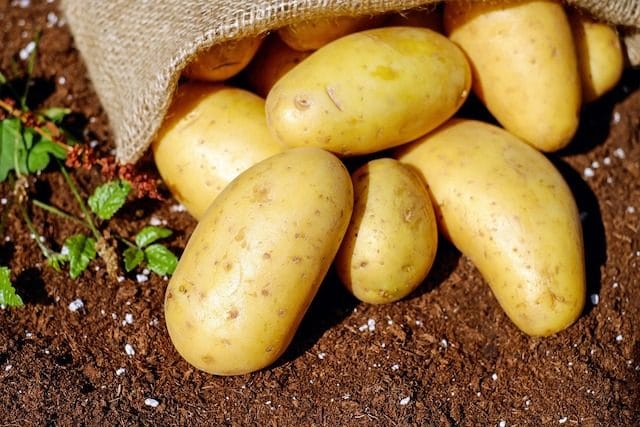The Americas have given several foods to the world, unknown outside North and South America before the arrival of the Europeans in the late 15th century. Some of them have been used to create prepared dishes, samples of the culinary arts virtually unknown outside their country of origin. Others have become staples across the world. Plants native to the Americas created foods which later became critical parts of diets internationally, including both corn and the humble potato. Corn is the English name for maize, indigenous to the Americas, and now the most widely harvested cereal grain in the world.
From the native plants and game, as well as those husbanded by farmers, prepared dishes were created which remain relatively unknown outside of the Americas, and to many visiting there a decidedly acquired taste. Others, such as American produced cheeses, have become popular in Europe and Asia. Here are 10 foods born in the Americas from indigenous ingredients, some widely known, and others less so.
10. Cornbread
Cultivated maize, which the English-speaking world calls corn, originated in Central America and spread across South and North America before the arrival of the Spanish in the late 15th century. The Spaniards and Portuguese found the natives eating ground maize, mixed with water, and baked on rocks or in ovens. When the Europeans landed in North America they found the local tribes doing the same thing. The English settlers adopted the practice, though they also cooked ground corn into a thick porridge, known today as spoon bread.
The development and widespread availability of leavening agents such as baking powder allowed the porridge mixture to be baked rather than boiled, and cornbread was the result. Cornbread was carried by workers for their lunch, by students in schools, and by travelers for sustenance between distant and often dubious dining facilities. Later it was baked in muffin tins, in flat cakes, in special cast iron molds resembling an ear of corn, and in loaves. In devout Puritan New England It was baked before the Sabbath for consumption the following day. It became widely popular, especially among the less affluent across North America. It was far more affordable than breads and biscuits made from expensive wheat flours.
Cornbread, leavened and baked in a cast iron skillet became especially popular in the antebellum South, and remains so today. In New England of the same era the dish was known as corn cake, and typically made of ground corn, butter, salt, and flour. Today sugar is often added. Cornbread can rightly take the place as America’s bread, just as the baguette is France’s native bread. Though not widely consumed in Europe, cornbread is part of cuisines around the world, an understandable use of the world’s most harvested grain.
9. Gumbo
Gumbo is a dish, or rather a class of dishes, unique to the United States, originating in the Louisiana region. The area was a melting pot of French, Spanish, English, African, and Native American peoples and cultures in the late 18th and early 19th centuries, when gumbo first appeared on tables and in camps. The name itself comes from a West African word for okra, an essential ingredient of the dish. Flavoring of dried, ground sassafras leaves known today as “filè” came from the Native Americans. Gumbo is based on a thick, dark roux, a contribution from French cooking.
Gumbos contain a nearly unlimited list of animal protein, including sausage, pork, chicken, turkey, shrimp, oysters, crabmeat, ham, rabbit, beef, and whatever the cook has at hand. Some special gumbos are made for seasonal celebrations. Others are stews made over the fire in fishing and hunting camps. Today, gumbos can be found across North America, but it remains most popular in the South, and especially in the Cajun region of Louisiana. It is usually served with rice, another staple of the region.
Gumbo appears in two distinct versions, according to fans of the dish, Creole and Cajun. Creole is sometimes called New Orleans style gumbo. There are so many different recipes and ingredients that it can be safely said that no two gumbos are alike. Outside the United States it is virtually unknown.
8. Monterey Jack
In 1770 the second Spanish mission in what eventually became California was created in Monterey. There the missionaries grew crops familiar to them from Spain, including olives and oranges, and raised cattle. From the latter they preserved the milk in the manner of the old world, converting it to cheese. The soft white cheese provided a food source, as well as an income when it was sold. In 1848, after the Mexican American War, the Treaty of Guadalupe Hidalgo ceded California to the United States.
The discovery of gold in California generated the Gold Rush in 1849, followed by an influx of land speculators, among them David Jack. Through a series of quasi-legal procedures Jack obtained title to most of Monterey, including ownership of the dairies and farms which had grown in the years since the arrival of the Spanish monks. He recognized the market value of the locally produced cheese and began selling it commercially as “Jack’s Cheese.” Eventually it became known as Monterey Jack’s cheese. Flavored jack’s, such as pepper jack, came much later.
Whomever actually created the recipe remains debated, and today it is a type of cheese rather than a specific brand. Monterey Jack is the cheese of choice when making white queso dips and in other Mexican and Californian style cookery. Though highly popular in North America and Mexico, it is not the most popular white cheese among Americans. That distinction belongs to mozzarella, brought to the United States by Italians, and widely viewed as an essential topping for pizza.
7. Buffalo Wings

Buffalo Wings are an American creation, the means of eating chicken wings, long held in disdain by most, as a snack food, an appetizer, or as a means of contesting how much spicy heat one can consume. Buffalo, New York, claims title as the Chicken Wings Capital of the World, but several entities within that community stake competing claims for being the originator of the dish. American football led to the spread of chicken wings a la Buffalo when the Buffalo Bills went to the Super Bowl, and the pregame media frenzy displayed the dish on television screens across the country.
Buffalo’s Anchor Bar proudly displays a large sign proclaiming itself as the “Home of the Original Buffalo Chicken Wings”. At least four other establishments in Buffalo dispute that claim. And their dispute isn’t a mere family spat within the community. There are claims the idea of coating fried chicken wings with a spicy sauce, the essence of Buffalo Wings, originated far from the city on Lake Erie.
One such claim comes from a city on another of the Great Lakes. Some food experts have cited Chicago as the first to regularly serve the concoction. They appeared in Chicago speakeasies during Prohibition, part of the “free lunch” which encouraged customers to purchase more illegal alcohol. Chicken wings were so cheaply obtained from the slaughterhouses the speakeasies could afford to give them away. The spicy sauce, sometimes called Mumbo Sauce, originated in a Chicago barbecue restaurant. Sorry, Buffalo.
6. Clam Chowder
The east coast of North America and its tidal estuaries teemed with clams, oysters, mussels, scallops, and other forms of shellfish. They were easily obtained by anyone in the early colonial days and remained so for over a century. Either New Englanders in Massachusetts or Rhode Island or fishermen in Nova Scotia invented the dish known as clam chowder, with the stronger argument belonging to the latter.
In the New York region, the influx of Italian immigrants led to the addition of tomatoes to a clam broth, and the style known as Manhattan Clam Chowder. Some consider it a near-heresy to call it chowder at all. James Beard called the Manhattan version a “rather horrendous soup”. There are other styles of clam chowder, with different ingredients used in their preparation, but all came from North America.
The argument favoring the Nova Scotian fisherman comes from the name chowder. It is derived from the French chaudière, meaning a cauldron. French fishermen encountered the Natives eating clams and edible tubers boiled together in a pot, and adopted the idea, also using other forms of seafood which they had caught. The soup was then thickened with crumbled ship’s bread, known as hardtack, so hard it was nearly inedible without softening it. Clam Chowder in all its forms traveled across America during the westward migration, and found another ready supply of its main ingredient along the Pacific coast.
5. Maple syrup and sugar

The English settlers in New England noticed the Native tribes slicing through the bark of maple trees and acquiring the sap which flowed from them each spring. The sap was used as a flavoring by boiling food, especially meat from game, in the sap. The process sweetened the meat. Boiling the sap alone produced maple sugar, which the Native tribes used as a sweetener or ate as candy. The English quickly adopted the practice. Maple sugar was also a valued trade item. Maple syrup, as we now know it, was avoided because there was no practical way to store it.
Maple sugar was traded among the English colonies, since it was far less expensive than the sugar produced by the plantations in the West Indies. Both George Washington and Thomas Jefferson planted maple groves on their Virginia plantations. By then, improvements in storage had also made maple syrup a valuable commodity. Washington prized maple syrup on ice cream, one of his favorite desserts at Mount Vernon. Maple syrup production became a leading industry in the young United States, with New England the leading producer.
The deciduous sugar maple from which the delicious syrup and sugar was obtained is native to the northeastern United States and lower Canada. Maple syrup and sugar are thus both foods born in the Americas, still consumed more there than anywhere else in the world. Unfortunately, very few of the bottles of syrup found on grocer’s shelves today contain true maple syrup, which is often used just as a flavoring for corn syrup. Maple sap for syrup can only be obtained once per year. Pure maple syrup today is considerably more expensive than its faux rivals, and as a result, many Americans have never tasted the real thing. It’s their loss.
4. Chocolate

The Spanish and Portuguese explorers and conquerors in Central and South America found the natives drinking a beverage made from the seeds of the cocoa (also called cacao) tree, a plant then unknown to the Europeans. The Mayans called the beverage xocoatl, meaning “bitter water,” which gives an indication of the drink’s qualities. The ancients used the drink as a health tonic, and assuaged the bitterness with a variety of flavorings though sugar, being unknown to them, was not one of them. Columbus discovered the beverage on his fourth voyage, though it was Hernan Cortez who first brought the seeds to Spain in 1528, along with the steps for processing them into a beverage.
To Cortez goes the credit for adding sugar to the bitter drink, which made it infinitely more palatable, and it became a beverage for the nobility, as only they could afford it. The French discovered how to use chocolate in candy in the mid-17th century. Later that same century, London coffee houses served cakes and rolls flavored with chocolate and sugar. Chocolate remained a flavoring or beverage until 1830, when the British discovered the method of making hardened chocolate for eating. Finally, in 1875, a Swiss chocolatier created milk chocolate. In 1910 Swiss chocolate was named a national food by the Swiss government.
Today chocolatiers from around the globe tout the superiority of their chocolate products, and it flavors foods all over the world. It comes in numerous varieties, including milk chocolate, semi-sweet, unsweetened, dark, and others. Very few link it to an ancient food and beverage known only to the natives of Mesoamerica before the coming of the Europeans in the 15th century. Switzerland today is the largest per capita consumer of chocolate in the world, followed by Austria. The Swiss consume almost 19 and a half pounds of chocolate per person per year, twice the amount consumed by Americans. About 19% of Swiss adults are considered obese, in the United States, over 36%. Go figure.
3. Potatoes

The potato first underwent cultivation in ancient South America, and before the Europeans came to the New World it had spread through the Andes and into Central America. The ancients used potatoes in manners similar to today, including boiling, baking, and mashing them. When ships returned to Spain from the region, sailors carried the potato with them, to supplement their diets of salt meat and hard bread. Potatoes were considered unsuitable for consumption by civilized people in Spain and Portugal in the 1500s. Its use grew slowly in Europe, until it gradually came to be viewed as a food suitable for the consumption of peasants and soldiers. By the late 18th century, the potato was consumed widely in Britain and Ireland, and it had gained favor in France as well.
The Old World returned the potato to the New with the English colonies in the 18th century. By the middle of the century it was widely cultivated and consumed on both sides of the Atlantic. It offered the advantages of being adaptable for long-term storage, and was cheap and relatively easy to grow. The Catholic Churches, both Roman and Eastern Orthodox, considered the potato warily, the former because it was grown underground, the latter because it was not mentioned in the Bible.
A long-standing myth that the potato chip was invented in America by a chef in Saratoga, New York in 1853 is disproved by recipes for the snack being recorded decades earlier. But there is no question the potato itself originated in the Americas, and was only grudgingly accepted as a food source by the rest of the world in the ensuing centuries. Today there are about 5,000 different types of potatoes worldwide, with 99% of them being traced by DNA to a type originating in ancient Chile.
2. Colby Cheese
A cheesemaker named Joseph Steinwand developed an entirely new type of orange cheese in 1885, according to some as part of deliberate experimentation. Others say the discovery was an accident, caused by his inattention during the cheddaring process of making cheese. Whichever it was, the new cheese had a milder flavor than aged cheddar, and was not as dry. It could also be made more quickly than cheddar, since it did not involve the complicated cheddaring process to prepare the cheese for curing and aging.
Rather than naming it for his own factory, Steinwand christened the new cheese Colby cheese, after the town of Colby, Wisconsin where it was first made. His cheese is what is known as a semi-hard cheese, orange in color, with irregular holes, and a slightly grainy texture. It is frequently produced in long cylinders called Longhorns, which gives the cheese the additional name of Longhorn Colby Cheese.
Colby can be called the first truly American cheese, since it was made in America and was not an attempt to imitate or improve on an existing European cheese. Cheesemakers have blended it with that other American cheese, Monterey Jack, to make a popular snacking cheese. Colby (and Monterey Jack) represents a significant portion of the nearly $1.4 billion the US exports in cheese each year, making it the fifth largest exporter of cheese in the world.
1. Jambalaya
Like gumbo, jambalaya comes in both Creole and Cajun versions, and both rely on a staple of Louisiana cooking known as the trinity (onions, celery, and bell pepper, all finely chopped). It contains elements of Spanish, French, Native, and African cuisine. The Creole version relies on tomatoes as part of the mix. The Cajun version does not, with a concentration of other vegetables. Even the name seems to have come from a combination of French, Spanish, and a local Native tribe.
Both versions contain elements of the Spanish dish paella, but jambalaya is unique to the southern United States. A version emerged near Charleston, South Carolina, but it likely came from the seamen who first encountered it in New Orleans, rather than the local population. All versions combine meats or seafood or both with rice and the flavorings which came from French, Spanish, and African foods. Cajun versions of the one pot dish often included alligator meat. Creole versions incline toward shrimp and chicken. Both rely on sausage, usually andouille.
The dish is uniquely American, and outside of the Atlantic and Gulf coastal regions remained little known until the advent of cooking networks, which made formerly unknown cuisine available 24 hours per day. Prior to the widespread availability of recipes, as with its distant cousin gumbo, nearly every jambalaya was different, with cooks using the ingredients available to make a hearty and filling dish. It was often served with cornbread, another distinctly American food. In fact, one recipe combines jambalaya with maple sweetened cornbread, a marriage of several foods born entirely in the Americas.